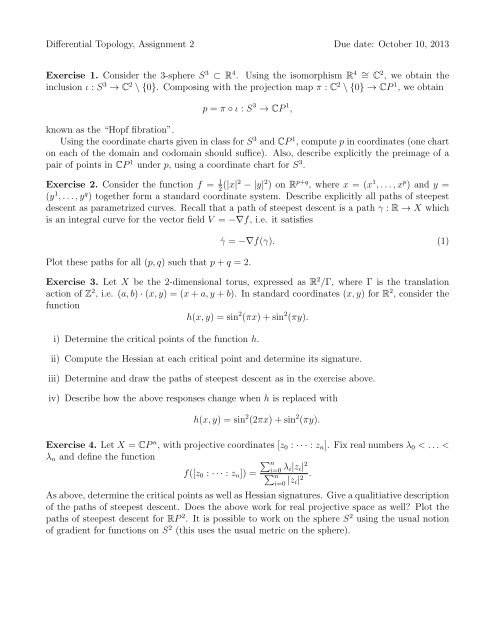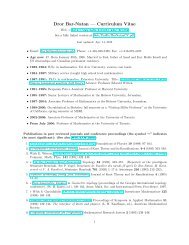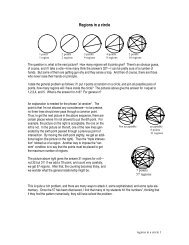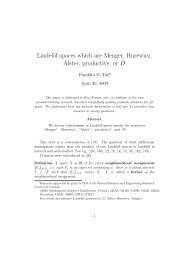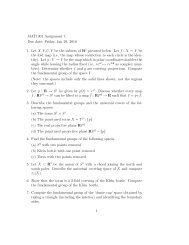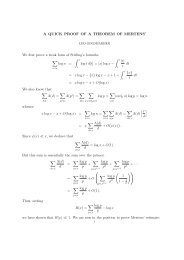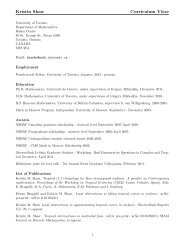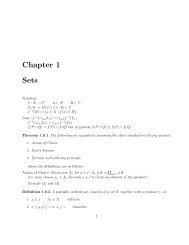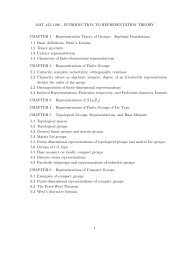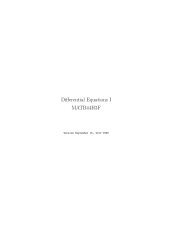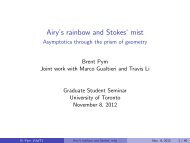Differential Topology, Assignment 2 Due date: October 10, 2013 ...
Differential Topology, Assignment 2 Due date: October 10, 2013 ...
Differential Topology, Assignment 2 Due date: October 10, 2013 ...
Create successful ePaper yourself
Turn your PDF publications into a flip-book with our unique Google optimized e-Paper software.
<strong>Differential</strong> <strong>Topology</strong>, <strong>Assignment</strong> 2 <strong>Due</strong> <strong>date</strong>: <strong>October</strong> <strong>10</strong>, <strong>2013</strong><br />
Exercise 1. Consider the 3-sphere S 3 ⊂ R 4 . Using the isomorphism R 4 ∼ = C 2 , we obtain the<br />
inclusion ι : S 3 → C 2 \ {0}. Composing with the projection map π : C 2 \ {0} → CP 1 , we obtain<br />
p = π ◦ ι : S 3 → CP 1 ,<br />
known as the “Hopf fibration”.<br />
Using the coordinate charts given in class for S 3 and CP 1 , compute p in coordinates (one chart<br />
on each of the domain and codomain should suffice). Also, describe explicitly the preimage of a<br />
pair of points in CP 1 under p, using a coordinate chart for S 3 .<br />
Exercise 2. Consider the function f = 1 2 (|x|2 − |y| 2 ) on R p+q , where x = (x 1 , . . . , x p ) and y =<br />
(y 1 , . . . , y q ) together form a standard coordinate system. Describe explicitly all paths of steepest<br />
descent as parametrized curves. Recall that a path of steepest descent is a path γ : R → X which<br />
is an integral curve for the vector field V = −∇f, i.e. it satisfies<br />
Plot these paths for all (p, q) such that p + q = 2.<br />
˙γ = −∇f(γ). (1)<br />
Exercise 3. Let X be the 2-dimensional torus, expressed as R 2 /Γ, where Γ is the translation<br />
action of Z 2 , i.e. (a, b) · (x, y) = (x + a, y + b). In standard coordinates (x, y) for R 2 , consider the<br />
function<br />
h(x, y) = sin 2 (πx) + sin 2 (πy).<br />
i) Determine the critical points of the function h.<br />
ii) Compute the Hessian at each critical point and determine its signature.<br />
iii) Determine and draw the paths of steepest descent as in the exercise above.<br />
iv) Describe how the above responses change when h is replaced with<br />
h(x, y) = sin 2 (2πx) + sin 2 (πy).<br />
Exercise 4. Let X = CP n , with projective coordinates [z 0 : · · · : z n ]. Fix real numbers λ 0 < . . . <<br />
λ n and define the function<br />
∑ n<br />
i=0<br />
f([z 0 : · · · : z n ]) =<br />
λ i|z i |<br />
∑ 2<br />
n<br />
i=0 |z i| . 2<br />
As above, determine the critical points as well as Hessian signatures. Give a qualitiative description<br />
of the paths of steepest descent. Does the above work for real projective space as well? Plot the<br />
paths of steepest descent for RP 2 . It is possible to work on the sphere S 2 using the usual notion<br />
of gradient for functions on S 2 (this uses the usual metric on the sphere).
<strong>Differential</strong> <strong>Topology</strong>, <strong>Assignment</strong> 2 <strong>Due</strong> <strong>date</strong>: <strong>October</strong> <strong>10</strong>, <strong>2013</strong><br />
Exercise 5. Recall that Gr(k, V ) is the set of k-dimensional subspaces of the vector space V .<br />
Normally we take V = C n and write Gr(k, n). We will focus on Gr(2, 4) in this exercise. Fix a<br />
basis (e 1 , e 2 , e 3 , e 4 ) for the purpose of defining a full flag F in V , meaning a sequence of subspaces<br />
{0} = F 0 ⊂ F 1 ⊂ F 2 ⊂ F 3 ⊂ F 4 = V,<br />
where F i = Span(e 1 , . . . , e i ). Any point Λ ∈ Gr(2, 4) may then be intersected with the flag, giving<br />
subspaces<br />
Λ ∩ F 1 ⊂ Λ ∩ F 2 ⊂ Λ ∩ F 3 ⊂ Λ. (2)<br />
For most (or an open dense set of, or generic choice of) Λ, the first two subspaces in the above<br />
sequence would be zero, and Λ ∩ F 3 would be 1-dimensional. This set of Λ is called W 0,0 , the<br />
largest “Schubert cell” and is the “usual case”. In general, for special elements Λ ∈ Gr(2, 4), the<br />
1-dimensional intersection in (2) may happen a 1 places earlier than usual, and the 2-dimensional<br />
intersection may happen a 2 places earlier than usual, where a 1 ≥ a 2 . So we may define subsets<br />
W a1 ,a 2<br />
for any such pair (a 1 , a 2 ). For example,<br />
W 1,1 = {Λ ∈ Gr(2, 4) : dim(Λ ∩ F 1 ) = 0 and dim(Λ ∩ F 2 ) = 1 and dim(Λ ∩ F 3 ) = 2.}<br />
i) A point Λ ∈ Gr(2, 4) may be described by giving a spanning pair of vectors for the 2-<br />
dimensional subspace it represents. We express this pair of vectors in terms of the chosen<br />
basis above, and arrange them as the rows of a 2 × 4 matrix<br />
( )<br />
∗ ∗ ∗ ∗<br />
λ =<br />
,<br />
∗ ∗ ∗ ∗<br />
with the understanding that two matrices λ, λ ′ represent the same element of the Grassmannian<br />
when λ = gλ ′ for some g ∈ GL(2, C). Prove that W 1,1 is in bijection with matrices of the<br />
form<br />
( )<br />
∗ 1 0 0<br />
λ =<br />
,<br />
∗ 0 1 0<br />
and obtain analogous statements for the other Schubert cells W a,b , including the largest one.<br />
ii) There is a partial order on the Schubert cells, so that W a,b < W c,d when W a,b is contained in<br />
the closure of W c,d . Determine what the order relation is between the Schubert cells in Gr(2, 4)<br />
and draw the associated Hasse diagram.<br />
iii) By projectivizing C 4 to produce CP 3 , we see that 2-dimensional subspaces Λ ∈ C 4 correspond<br />
to projective lines in the 3-dimensional projective space CP 3 . In this way we see that Gr(2, 4)<br />
may be viewed as the space G(1, 3) of lines in CP 3 . The flag F then becomes a projective<br />
flag, consisting of a choice of point p, projective line l, and projective plane P in CP 3 such<br />
that p ∈ l and l ⊂ P . Give a geometric description of the closure of each of the Schubert<br />
cells in Gr(2, 4), using this projective model.


